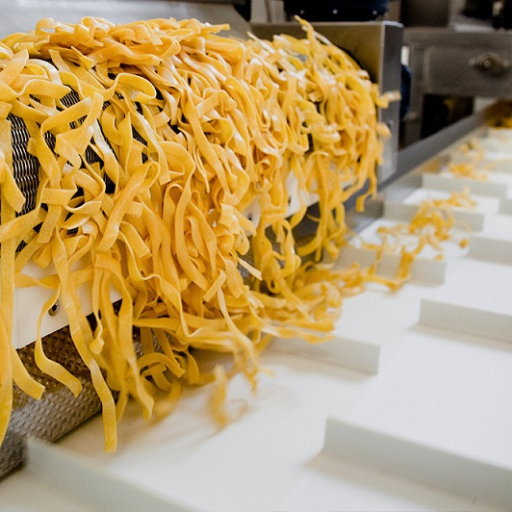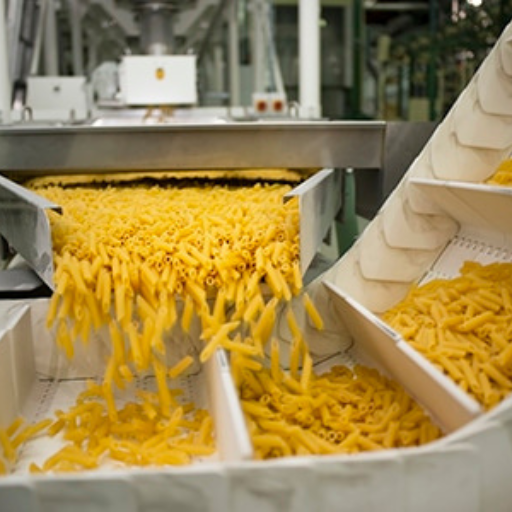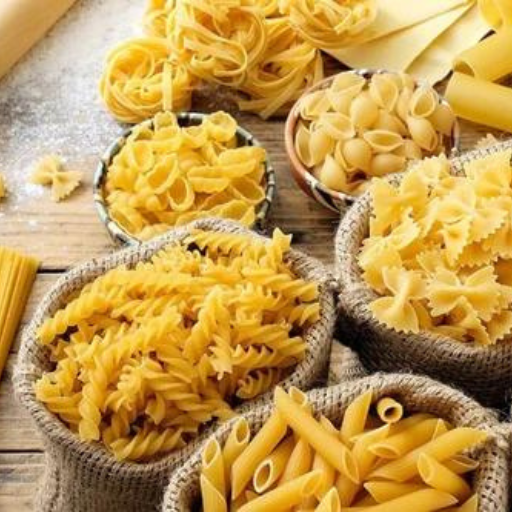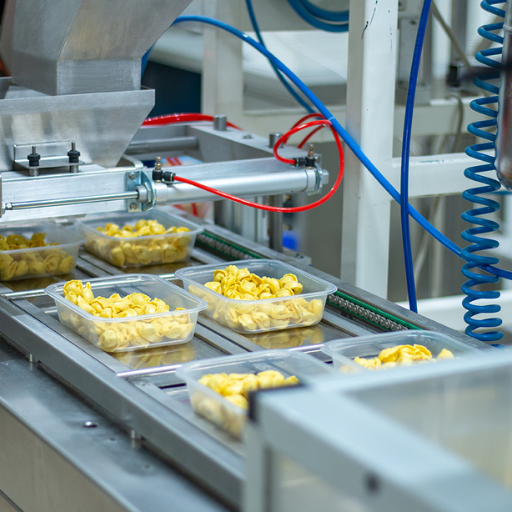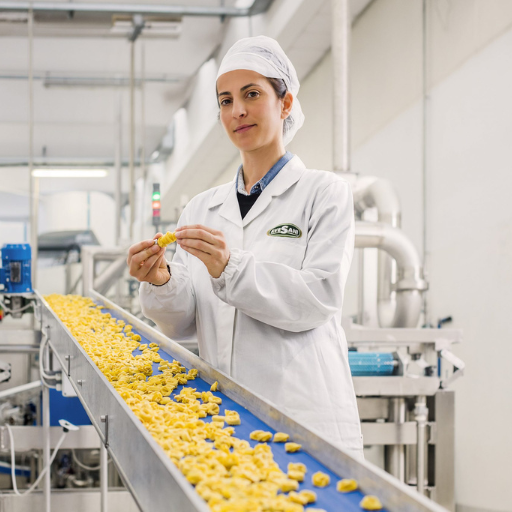In the modern food production industry, efficiency and quality are paramount, especially when it comes to staple products like pasta. This article aims to provide a comprehensive overview of the equipment and machinery essential for an efficient dry pasta production line. From mixing and kneading to drying and packaging, each stage of the pasta-making process involves specialized technology designed to ensure consistency, hygiene, and productivity. By the end of this blog, readers will gain a clear understanding of the core components required to set up or enhance a pasta production facility, along with insights into the latest innovations and best practices in the industry.
What are the Key Components of a Dry Pasta Production Line?
Required Machinery for Pasta Production
To have a functional dry pasta line, there are some specific machines that are needed in place. These include:
- Mixing and Kneading Machines: These are used to mix ingredients together and develop the dough to the right consistency.
- Extruders: They are employed in shaping the dough into various types of pasta such as spaghetti, penne, fusilli among others.
- Drying Systems: It helps to get rid of moisture from the pasta making it have a long shelf life without any decrease in quality.
- Cooling Conveyors: These are used to cool down the extruded pasta so as to prepare it for drying.
- Packaging Equipment: For hygienically packing and sealing pasta ready for sale and distribution.
These components ensure that high productivity standards, quality assurance, and hygiene is maintained at each step of producing paste.
Role of Extruders in Pasta Production
Extruders play an essential role in forming different kinds of pastas out of dough during the process. Initially, the mixed dough is fed into an extruder where it becomes pressurized and forced through dies or molds that have been purposely designed. In this way manufacturers can obtain a variety of pasta forms such as spaghetti, macaroni, fettuccine etc. Modernly designed extruders guarantee evenness both in terms of shape and texture which is quite important for uniform cooking quality and consumer satisfaction. Furthermore new type extrusion technology makes possible introduction of various additives including whole grain ingredients or gluten free ones making their production adaptable to market trends. As such efficient reliable extruders are pivotal for effective versatile high standard production processes.
Functions Of Dryers In Dry Pasta Production
Dryers form a significant part of dry pasta manufacturing since they aid in removing moisture from pasta enabling it stay on shelves for long periods without going bad. Most frequently encountered method involves a series of successive temperature controlled steps with decreasing humidity aimed at progressive reduction of the water content in pasta. Approximately it helps to preserve the texture, structure and prevent microbial growth, spoilage. Modern drying systems are built with elaborate technology that monitors and adjusts condition of pasta as it dries taking into consideration real time data ensuring highest quality preservation without any degradation. Thus, dryers that work efficiently help manufacturers to produce durable products that meet consumer expectations while adhering to regulatory norms.
How to Optimize Your Pasta Production Line?
Enhancing Production Capacities
Optimizing production capacities in a pasta production line is a complex process that demands multiple approaches. First, the installation of automated systems can boost output through minimizing manual involvement and improve accuracy in the manufacturing process. Advanced machines like mixers with high-caps, extruders, and continuous drying systems can be used to streamline operations thus enabling 24/7 production with minimum downtime.
Embracing predictive maintenance using IoT sensors and data analytics helps to avoid sudden breakdowns and ensure optimal operation of all equipment at peak efficiency. To prevent interruptions in the flow of production regular maintenance should be carried out on time so as to replace worn-out parts.
There is need for ongoing training and development so as to maximize efficiency. For instance, an experienced machine operator utilizing modern machinery can foresee a potential problem before it escalates while adapting quickly to new technologies or techniques. Therefore integration of these strategies results into increased capacity of production which makes the pasta production line work optimally and profitably.
Improving Machinery Efficiency
To achieve maximum output and cost reduction, there is a need to enhance machinery efficiency in the pasta production line. The following several methods have been suggested by leading sources:
- Regular Maintenance and Upgrades: Regular maintenance checks plus upgrading improve servicing durability hence preventing failures from occurring that will shorten life span of these equipments such as cleaning ,lubrication replacing some components which are worn out .
- Automation & Technology Integration: Streamlining operations through advanced automation and including modern techs such as AI (Artificial Intelligence) plus IOT (Internet Of Things). These technologies help operators to determine when machine failures are likely to occur by analyzing current data so that they make right decisions about preventive measures thus optimizing machine performance beforehand.
- Energy Efficiency: Operational costs can be substantially reduced by adopting energy efficient practices and machinery like use of energy efficient motors, optimization load management; incorporation regenerative braking system on conveyors among other moving parts to recapture energy.
By emphasizing on regular maintenance, utilizing advanced technology and prioritizing energy efficiency pasta production lines can achieve greater machinery efficiency thereby increasing overall productivity.
Ensuring Consistent Dry Pasta Quality
Consistent dry pasta quality is important for customer satisfaction and brand reputation. The following are some of the key strategies as per leading sources:
- Raw Material Quality: High quality durum wheat semolina is the basis for making good quality dry pasta. Good qualities of raw materials help in uniformity of texture and taste.
- Process Control: It is critical to have precise control over all stages of production including mixing, extrusion and drying. The use of automated systems that monitor parameters continuously in real time will lead to more consistent results.
- Drying Techniques: Pasta quality is largely influenced by the drying phase. This may include use of advanced drying techniques that regulate temperature and humidity precisely so that it prevents cracking or uneven texture problems.
- Quality Assurance Testing: Rigorous control measures should be implemented while moisture content tests, color tests and elasticity tests are done regularly as a way of meeting ultimate specification in the output.
Thus, with an emphasis on high-quality raw materials, tight process controls, advanced drying techniques, and extensive quality assurance testing, manufacturers can produce consistent dry pasta.
What Types of Pasta Machines are Available for Different Pasta Shapes?
Machines for Short-Cut Pasta
Short-cut pasta machines are intended to make penne, fusilli, macaroni and other short pasta shapes. These machines normally have extrusion systems which channel the pasta dough through specific dies in order to achieve the shapes desired. Below are some important features:
- Beside customization and versatility: Manufacturers mostly use these machines due to their ability of changing between different forms very quickly using interchangeable dies. This is a big advantage when dealing with different markets.
- Automated Systems: Present-day short-cut pasta machines come with highly advanced automation technology such as those supporting real-time monitoring and adjustment capabilities that ensure product consistency while minimizing ‘off-line’ manual interventions.
- Greater Efficiency and Output: These equipment support mass production so they produce at high rates without compromising on quality. Their design reduces waste and improves speed of production.
With customizable dies, enhanced automation, and effective production capabilities, short-cut pasta machines are indispensable tools for producers aiming at diversified types of good-quality pasta.
Long-Cut Pasta Machines
Long-cut pasta machines are specifically designed for making spaghetti, linguine or fettuccine. Such machinery has always been equipped with sophisticated technologies which enhance accuracy and efficiency in production processes. Some of its main features include:
- Die Plates within Extrusion Systems: Like their counterparts used for short-cut pastas, long cutters employ extrusion techniques where dough passes through particular die plates thus becoming elongated strands of spaghetti. It is possible to change the plates in order to create various elongated shapes.
- Sheeting & Cutting: Apart from certain types of long cutters that use sheeting process whereby dough is rolled into thin layers before being sliced into longer pieces; this ensures consistent thickness and texture which leads to quality products.
- Higher Capacity & Automation level: Thus modern long cutters are highly automated thereby allowing continuous manufacturing almost without human intervention . The automation includes real- time monitoring ,automatic adjustments among others as well as the best drying systems which are efficient enough making sure that there is no compromise on quality and quantities.
- Precision Drying: Proper drying ensures that long-cut pasta maintains its integrity during storage and cooking. These machines use advanced drying methods, controlling temperature and humidity to ensure optimum drying conditions.
Long-cut pasta machines are indispensable for producers seeking to make high-quality, lengthy pastas quickly by using interchangeable die plates, sheeting/cutting techniques, as well as state-of-the-art automation and drying technologies.
Machines for Special Pasta Shapes
Machines producing special pasta shapes such as farfalle, orecchiette or fusilli often have special molding and cutting systems built into them. Such systems allow for creation of intricate unique designs on the pasta that cannot be achieved through normal extrusion or sheeting techniques.
- Personalized Molds & Dies: These manufacturing tools employ custom molds and dies to make specific pasta shapes. Each mold/die set has been designed according to tolerances so as to guarantee production of consistently shaped pasta pieces with distinctive looks.
- Rotary Systems: Other types of special shape pasta machines use rotating systems in order to cut dough into different patterns or shapes. This technique is especially useful when creating complex shapes like radiatori or campanelle.
- 3D Forming Techniques: The most advanced 3D forming machines can produce specialized high-quality pasta shapes by means of multidimensional cutting/forming processes. Some complex hollow forms or textured surfaces supporting both visual and gourmet characteristics can be easily achieved using these devices.
- Efficient and Flexible Production: For example, pasta machines for making special shapes of pasta have been made to work in a flexible manner so that producers can switch between various moulds and dies with ease. This flexibility is important if the market has diverse pasta shapes, but efficiency must be maintained.
Special machines for shaping pasta are fitted with customized molds, rotary systems and advanced 3D forming techniques to facilitate the production of different kinds of unique and high-quality pastas.
How Does the Pre-Drying Process Work in Pasta Production?
Pre-Drying Stages in Pasta Production
In pasta production, pre-drying is an important stage that prepares the pasta for final drying while maintaining its shape and quality. The main stages involved in pre-drying are as follows:
- Initial Moisture Reduction: Freshly extruded pasta contains a lot of water. Therefore, during the first step of pre-drying it’s essential to gently reduce this moisture content so that it does not stick together or loose its structure. Normally this is done by controlled exposure to warm air whereby heat is evenly distributed.
- Conditioning: Conditioning involves progressive reduction of internal moisture levels within the pasta. It is done through regulated temperature air circulation ensuring uniform drying without cracks or defects. During this phase, low to medium temperatures with continuous flow of air is more favorable.
- Surface Drying: In the final stage of pre-drying, we dry the outermost layer up to some specific level of moistness. At this point, we make sure that the surface becomes hard enough to withstand handling and then drying until it gets dry completely. More heat is normally applied on pasta during this period so that they can be dried on the surfaces.
With these stages well coordinated, pasta makers can maintain their product’s integrity, texture and quality throughout all production stages.
Benefits of Effective Pre-Drying
Effective pre-drying has several advantages that improve overall quality and productivity in terms of manufacturing processes. First and foremost, it prevents clumping allowing each individual piece to remain in shape and with texture intact. Secondly, structural stability reduces chances of cracking or breaking when undergoing final drying and packaging processes respectively. Finally, accurate control over moisture at different periods under which pre-dryings take place guarantees consistent cooking performance without any unevenness among other benefits; therefore better culinary satisfaction for customers who use such commodities.Finally efficient pre- drying could enhance shelf life thereby extending its shelf life thus preserving its taste and nutritional value.
Some Issues with Pre-Drying and Their Solutions
- Uneven Drying: One of the most common challenges faced in pre-drying is non-uniform drying for all pasta products, which might experience some parts being over dried while others remain moist.
- Solution: By devising a proper air flow system within the drying chambers, heat and air can be more evenly spread. Also, rotating trays with pasta around and consistent monitoring of moisture levels will ensure much uniformity.
- Temperature Control: Poor temperature regulation may lead to fast drying causing surface cracks or slow drying leading to microbial growth.
- Solution: This problem can be avoided by using automated dryers with accurate thermostats. It is advisable that these gadgets are frequently checked and maintained at their optimum for purposes of efficient drying.
- Humidity Regulation: Correct humidity is important. If there is too much humidity, then the process becomes slow and it causes unevenness in drying; on the other hand if there is little humidity, the product dries faster but not uniformly.
- Solution : To achieve this target, hygrometers should be used to monitor relative humidity in the chamber while dehumidifiers or humidifiers adjusted accordingly wherever necessary. Additionally this involves sealing off the area from external environment that may cause its fluctuation as well.
In addressing pasta producers’ common challenges of targeted solutions, the efficiency, and reliability of the pre-drying process can be improved to produce a high-quality finished product.
What are the Maintenance Requirements for a Pasta Production Line?
Routine Machinery Inspections
As a line attendant for pasta production, my main priority is regular machinery inspections to ensure that the machinery operates optimally and prevent any unexpected downtimes. This involves routine examination of all moving parts, checking for signs of wear and confirming whether lubrication levels are adequate. By following an inspection schedule consistently, I can detect potential problems early enough to perform preventive maintenance and avoid costly repairs. Alongside this, all inspections and maintenance operations should be documented in order to track the performance of the machines over time and thus be consistent with industry standards.
Preventive Actions for Smooth Production Processes
My focus on several preventive actions is geared towards ensuring smooth production processes. First, I have a well laid down cleaning program for all equipment which ensures that there are no sources of contamination and that the machines run smoothly. It also entails periodic sanitation activities as well as thorough examinations for any traces of residuals or foreign substances. Second, calibration exercises are done on a regular basis in order to maintain precision in measurements since it is vital when it comes to product uniformity. On top of this, standardized procedures of operation have been established besides continuous training programs being available for all employees aimed at keeping up best practices by eliminating errors hence prompt addressing any arising challenges. Through giving more emphasis on these preventative actions, I am able to decrease interruptions during production thereby maintaining quality in terms of pasta produced.
Frequently Asked Questions (FAQs)
Q: What are the main parts of a dry pasta production line?
A: It is the usual thing to find mixers, extruders, dryers, pre-dryers, cooling conveyors, and packaging machines in a dry pasta production line. These devices work together to produce premium quality dried pasta rapidly.
Q: How is fettuccine produced in an industrial pasta processing line?
A: In an industrial pasta processing line, fettuccini is produced by feeding flour into mixing and extruding equipment for making dough that is then cut into flat thin strips by specialized cutting tools designed for this purpose.
Q: What precautions should be taken to ensure quality pasta during production?
A: Consistent ingredient quality (primarily wheat flour), dough moisture control, drying temperatures optimization are important aspects that may influence the quality of pasta while using advanced machinery like industrial lines will maintain these parameters.
Q: How does a pre-dryer function in a short-cut dry pasta production line?
A: The main role of a pre-dryer in a short-cut dry pasta production line is removing some moisture so that it does not stick together and therefore prepares it for final drying. This phase helps achieve the desired mouthfeel as well as shelf life.
Q: How can one reduce energy consumption in a dry pasta processing line?
A: Power demand can be minimized by utilizing energy saving machines, optimizing drying process steps through plant layout design strategy development; ensuring regular maintenance schedule on all equipments installed especially burner motors which typically require more fuel than others types when operated at their optimum levels-and lastly adopting technologies such as Heat Recovery Systems which enable them operate more efficiently without extra cost burdening their users. Advanced machineries such as those from SARP have immense potential to increase energy efficiency across many segments within manufacturing environments.
Q: What types of pasta can be produced using dry pasta lines?
A: Spaghetti-like long pastas, penne type short cut pasta and macaroni as a cut dry pasta are some of the various kinds which can be made by dry paste lines. They are flexible and their processing can be adjusted to make different shapes and sizes distil.












